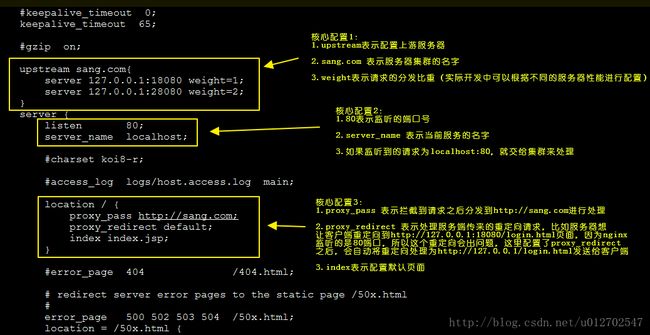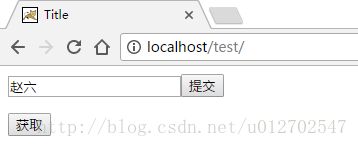Nginx负载均衡实现Session共享
小伙伴们好久不见!最近略忙,博客写的有点少,嗯,要加把劲。OK,今天给大家带来一个JavaWeb中常用的架构搭建,即Nginx+Tomcat搭建服务集群,然后通过Spring Session+Redis实现Session共享。
阅读本文需要有如下知识点:
1.Nginx的安装、配置
2.Spring+SpringMVC基本配置
3.Redis缓存的使用
Nginx和Redis我打算后期写几篇博客来介绍,这里小伙伴如果对这两个概念不懂的话可以先自行百度,对于Spring+SpringMVC的使用如果小伙伴有疑问,可以移步这里Spring&SpringMVC框架。
创建Maven项目,添加依赖
使用IntelliJ IDEA创建Maven项目,并添加相关依赖,依赖如下:
<dependencies>
<dependency>
<groupId>redis.clientsgroupId>
<artifactId>jedisartifactId>
<version>2.9.0version>
dependency>
<dependency>
<groupId>org.springframework.datagroupId>
<artifactId>spring-data-redisartifactId>
<version>1.8.4.RELEASEversion>
dependency>
<dependency>
<groupId>org.springframework.sessiongroupId>
<artifactId>spring-sessionartifactId>
<version>1.3.1.RELEASEversion>
dependency>
<dependency>
<groupId>org.apache.commonsgroupId>
<artifactId>commons-pool2artifactId>
<version>2.4.2version>
dependency>
<dependency>
<groupId>org.springframeworkgroupId>
<artifactId>spring-webmvcartifactId>
<version>${spring-framework.version}version>
dependency>
dependencies>- 1
- 2
- 3
- 4
- 5
- 6
- 7
- 8
- 9
- 10
- 11
- 12
- 13
- 14
- 15
- 16
- 17
- 18
- 19
- 20
- 21
- 22
- 23
- 24
- 25
- 26
- 27
- 28
- 29
- 30
- 31
这里要添加的依赖略多,不过大致可以分为如下三类:
1.Redis的Java客户端,这个通过Java代码来操作Redis
2.Spring Data Redis,这个用来简化Redis操作
3.Spring Session,这个用来进行Session的管理
4.Spring
搭建Spring+SpringMVC环境
首先在resources文件夹下创建spring+springmvc的配置文件: 
然后在web.xml文件中配置spring和springmvc,如下:
<context-param>
<param-name>contextConfigLocation</param-name>
<param-value>classpath:applicationContext.xml</param-value>
</context-param>
<listener>
<listener-class>org.springframework.web.context.ContextLoaderListener</listener-class>
</listener>
<servlet>
<servlet-name>springmvc</servlet-name>
<servlet-class>org.springframework.web.servlet.DispatcherServlet</servlet-class>
<init-param>
<param-name>contextConfigLocation</param-name>
<param-value>classpath:spring-servlet.xml</param-value>
</init-param>
<load-on-startup>1</load-on-startup>
</servlet>
<servlet-mapping>
<servlet-name>springmvc</servlet-name>
<url-pattern>/</url-pattern>
</servlet-mapping>- 1
- 2
- 3
- 4
- 5
- 6
- 7
- 8
- 9
- 10
- 11
- 12
- 13
- 14
- 15
- 16
- 17
- 18
- 19
- 20
然后在applicationContext.xml文件中简单的配置一下spring,如下:
<context:component-scan base-package="org.sang" use-default-filters="false">
<context:exclude-filter type="annotation" expression="org.springframework.stereotype.Controller"/>
context:component-scan>- 1
- 2
- 3
配置Spring容器要扫描的注解。
然后在spring-servlet.xml中配置SpringMVC容器要扫描的注解,如下:
<beans xmlns="http://www.springframework.org/schema/beans"
xmlns:xsi="http://www.w3.org/2001/XMLSchema-instance" xmlns:mvc="http://www.springframework.org/schema/mvc"
xmlns:context="http://www.springframework.org/schema/context"
xsi:schemaLocation="http://www.springframework.org/schema/beans http://www.springframework.org/schema/beans/spring-beans.xsd http://www.springframework.org/schema/mvc http://www.springframework.org/schema/mvc/spring-mvc.xsd http://www.springframework.org/schema/context http://www.springframework.org/schema/context/spring-context.xsd">
<mvc:annotation-driven/>
<context:component-scan base-package="org.sang" use-default-filters="false">
<context:include-filter type="annotation" expression="org.springframework.stereotype.Controller"/>
context:component-scan>
beans>- 1
- 2
- 3
- 4
- 5
- 6
- 7
- 8
- 9
- 10
- 11
- 12
spring-servlet.xml的配置相对要简单一些。
OK,至此,Spring+SpringMVC的环境就搭建成功了。
配置Spring Session和Redis
Session一直是我们做集群时一个比较头疼的问题,之前有一个GitHub上的开源控件tomcat-redis-session-manager,但是这个东西目前只支持到Tomcat7,不是最佳选项,我们也可以使用Nginx提供的ip_tables,将同一个请求ip定位到同一台服务器上,但是这样没有办法充分利用服务集群的性能,Spring Session的出现可以很好的帮助我们解决这些问题,它具有如下特点:
1.Spring Session提供了redis、jvm的map、mongo、gemfire、hazelcast、jdbc等多种存储session的容器的方式。
2.同一个浏览器同一个网站,支持多个session。
3.不依赖于cookie。可通过header来传递sessionID
4.WebSocket和spring-session结合,同步生命周期管理。
5.使用简单
OK,接下来我们来看看怎么配置我们的Spring Session,首先在web.xml文件中添加过滤器:
<filter>
<filter-name>springSessionRepositoryFilterfilter-name>
<filter-class>org.springframework.web.filter.DelegatingFilterProxyfilter-class>
filter>
<filter-mapping>
<filter-name>springSessionRepositoryFilterfilter-name>
/*
filter-mapping>- 1
- 2
- 3
- 4
- 5
- 6
- 7
- 8
这里使用了Spring Web提供的代理过滤器,将拦截到的请求全部交给一个名为springSessionRepositoryFilter的过滤器进行处理。OK,然后在applicationContext.xml中配置Spring Session和Redis,如下:
class="org.springframework.session.data.redis.config.annotation.web.http.RedisHttpSessionConfiguration"/>
class="org.springframework.data.redis.connection.jedis.JedisConnectionFactory">
<property name="hostName" value="192.168.248.128"/>
<property name="port" value="6379"/>
<property name="database" value="0"/>
- 1
- 2
- 3
- 4
- 5
- 6
hostName即为redis的地址,port为redis的服务端口。
OK,写完这一切就OK了,我们来写一个简单的jsp页面测试一下,测试前记得启动你的redis服务哦。
测试
index.jsp页面如下:
<%@ page contentType="text/html;charset=UTF-8" language="java" %>
<html>
<head>
<title>Titletitle>
head>
<body>
<form action="/setsession">
<input type="text" name="name"><input type="submit" value="提交">
form>
<form action="/getsession">
<input type="submit" value="获取">
form>
body>
html>- 1
- 2
- 3
- 4
- 5
- 6
- 7
- 8
- 9
- 10
- 11
- 12
- 13
- 14
该页面我尽量做得简单,有两个按钮,第一个向session中存数据,第二个按钮从session中取数据,对应的Controller如下:
@Controller
public class HelloController {
@RequestMapping("/setsession")
@ResponseBody
public void setSession(HttpSession session, String name) {
session.setAttribute("name", name);
}
@RequestMapping(value = "/getsession",produces = "text/html;charset=utf-8")
@ResponseBody
public String getSession(HttpSession session, HttpServletRequest req) {
return session.getAttribute("name").toString()+"-----"+req.getServletContext().getRealPath("/");
}
}- 1
- 2
- 3
- 4
- 5
- 6
- 7
- 8
- 9
- 10
- 11
- 12
- 13
- 14
当我向httpsession中写数据时,这些数据会自动存储到redis缓存/数据库中。在返回session数据时我加上了项目部署路径,是为了在部署到集群上之后区分这个请求是由哪台服务器处理的。启动项目,页面如下: 
点击提交,会将数据保存到redis 中,如下: 
然后再回到起始页面,点击获取按钮,即可以拿到Session中的值,如下: 
OK,很简单吧!
至此,我们的Spring Session+Redis实现Session共享这个功能就完成了。接下来我们来看看如何为这个简单的web项目搭建集群。
搭建集群的准备工作
1.下载Nginx(地址http://nginx.org/),我这里使用的Nginx版本是nginx-1.12.0
2.下载Tomcat,我这里使用的Tomcat版本是apache-tomcat-8.5.12
网络拓扑图如下: 
将下载的Tomcat复制成两份,如下: ![]()
修改Tomcat的配置文件(conf/server.xml),重新设置端口号,每一个Tomcat的server.xml都需要修改三处,如下: 
要修改的地方有三处,我将给默认的端口号前面都加1,然后第二个Tomcat我给这三个地方的端口号前面都加2,这样方便我一会在同一台机器上跑多个Tomcat。
OK,做好这一切之后,可以先启动这两个Tomcat,看看能不能正常访问。
部署项目
OK,两台Tomcat都配置好之后,我们将刚才的项目拷贝到tomcat的webapps目录下,给两个Tomcat都拷贝。这里就不赘述了。
配置Nginx
下载Nginx,解压后,配置conf/nginx.conf文件,如下: 
配置完成后,启动nginx。再测试。
测试
向session中存数据: 
从session中取数据:
多取几次,你会看到请求是由不同的服务器处理的,如下: 

OK,至此,我们的所有工作就做完啦!有问题欢迎留言交流。项目下载地址:
http://download.csdn.net/detail/u012702547/9866761